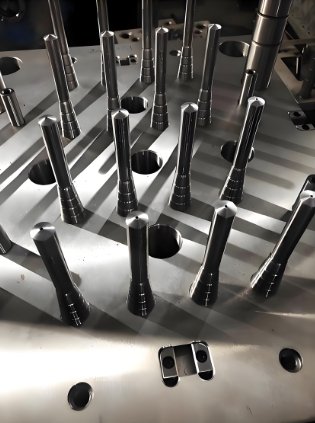
The medical industry demands high-precision components. Medical injection molding is evolving to meet stricter safety and quality standards. Mold makers are using advanced technologies to improve efficiency, accuracy, and material performance. This article explores the latest innovations shaping the future of medical injection molding.
Why Innovation Matters in Medical Injection Molding
1. Improving Patient Safety
New technologies reduce defects and contamination risks. This ensures safer medical devices.
2. Enhancing Precision
Advanced molding techniques create complex, miniaturized components. This improves device performance.
3. Reducing Production Costs
Automation and smart technologies streamline manufacturing. This lowers costs and increases efficiency.
4. Meeting Regulatory Standards
New materials and processes help manufacturers comply with strict FDA and ISO guidelines.
1. Micro Injection Molding for Miniature Medical Parts
What It Is
Micro injection molding produces tiny, high-precision components. These parts are often smaller than a grain of rice.
Why It’s Important
- Essential for miniaturized medical devices.
- Used in implants, drug delivery systems, and surgical tools.
- Reduces material waste and production costs.
Innovations in Micro Molding
- Nanotechnology coatings enhance material performance.
- Multi-shot micro molding allows multiple materials in one component.
- Laser-assisted micro molding improves accuracy and surface quality.
2. 3D Printing Integration in Mold Making
What It Is
3D printing is now used to create prototype molds and test new designs.
Why It’s Important
- Speeds up mold development.
- Reduces costs associated with traditional tooling.
- Enables rapid prototyping for new medical devices.
Advancements in 3D Printing for Molds
- Hybrid molds combine 3D printing with traditional steel molds.
- Bioprinting applications integrate living cells into injection-molded medical parts.
- AI-generated mold designs optimize cooling and material flow.
3. Smart Injection Molding with AI and IoT
What It Is
Smart molding uses AI (Artificial Intelligence) and IoT (Internet of Things) to monitor and optimize production.
Why It’s Important
- Reduces defects through real-time adjustments.
- Ensures consistent part quality.
- Predicts machine failures before they occur.
Smart Technology in Molding
- Real-time quality monitoring detects imperfections instantly.
- IoT-connected sensors track mold temperature, pressure, and cycle times.
- AI-driven predictive maintenance prevents downtime and reduces costs.
4. Liquid Silicone Rubber (LSR) Molding for Medical Applications
What It Is
LSR molding is used for soft, flexible, and biocompatible medical parts.
Why It’s Important
- Ideal for implants, seals, and tubing.
- Withstands extreme temperatures and sterilization.
- Offers excellent chemical and bacterial resistance.
Innovations in LSR Molding
- Self-lubricating LSR improves performance in joint implants.
- Antimicrobial LSR compounds prevent bacterial growth.
- Multi-material LSR molding integrates hard and soft components.
5. Sustainable and Biodegradable Medical Plastics
What It Is
New eco-friendly materials reduce environmental impact in medical manufacturing.
Why It’s Important
- Complies with increasing sustainability regulations.
- Reduces plastic waste in the medical industry.
- Maintains strength and biocompatibility.
Breakthroughs in Sustainable Plastics
- Plant-based biodegradable polymers for disposable medical tools.
- Recyclable medical-grade thermoplastics for long-term use.
- Low-carbon manufacturing techniques to cut energy consumption.
6. Overmolding and Multi-Shot Molding for Complex Devices
What It Is
Overmolding and multi-shot molding combine multiple materials into a single component.
Why It’s Important
- Improves device durability and performance.
- Eliminates the need for additional assembly.
- Creates soft-touch surfaces for patient comfort.
Latest Advances in Overmolding
- Conductive overmolding for smart medical wearables.
- Bio-based adhesives for stronger material bonding.
- Micro overmolding for ultra-small medical parts.
7. Cleanroom Manufacturing for Sterile Production
What It Is
Cleanrooms control air quality to prevent contamination during molding.
Why It’s Important
- Required for medical-grade production.
- Ensures compliance with ISO 14644 cleanroom standards.
- Protects parts from dust, bacteria, and other contaminants.
New Cleanroom Technologies
- Automated cleanroom robots reduce human contact with parts.
- Advanced air filtration systems improve sterility.
- Self-cleaning surfaces lower contamination risks.
8. High-Speed and High-Precision Molding Machines
What It Is
Next-generation molding machines offer faster cycle times and greater accuracy.
Why It’s Important
- Increases production speed without sacrificing quality.
- Reduces costs by improving efficiency.
- Supports mass production of medical devices.
Latest Features in Molding Machines
- Servo-driven precision controls for ultra-tight tolerances.
- Energy-efficient molding systems lower operational costs.
- Hybrid electric-hydraulic machines for better performance.
9. Blockchain for Traceability and Compliance
What It Is
Blockchain technology tracks every stage of the molding process for improved compliance.
Why It’s Important
- Ensures full traceability of medical components.
- Prevents counterfeit medical parts from entering the supply chain.
- Improves regulatory compliance with tamper-proof records.
Blockchain Innovations in Medical Injection Molding
- Smart contracts for automated supplier verification.
- Real-time tracking of raw materials for FDA compliance.
- Decentralized quality control records for audit transparency.
10. Digital Twins for Process Optimization
What It Is
Digital twins are virtual models of the injection molding process.
Why It’s Important
- Predicts defects before production starts.
- Optimizes mold design and process settings.
- Reduces trial-and-error in mold development.
Digital Twin Advancements
- AI-powered simulations for faster mold testing.
- Virtual reality (VR) integration for interactive mold design.
- Cloud-based digital twins for global manufacturing networks.
Innovation is transforming medical injection molding. Mold makers are using AI, IoT, and sustainable materials to enhance safety, precision, and efficiency. As new technologies emerge, the industry will continue to evolve, creating better and safer medical devices. Keeping up with these advancements ensures manufacturers remain competitive while meeting strict regulatory standards.
